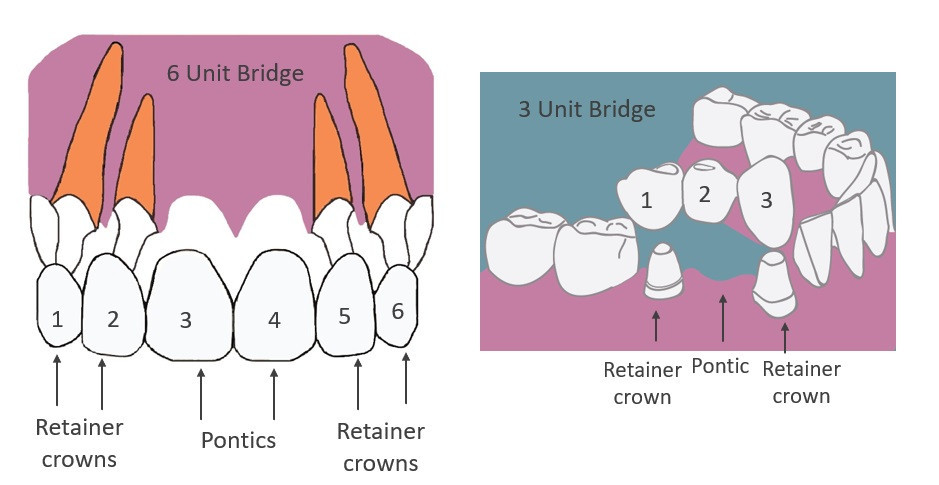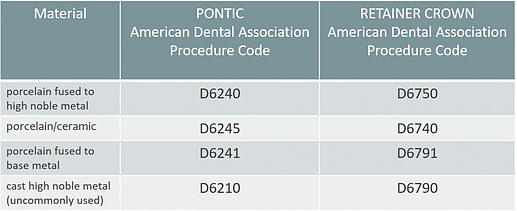If you’re considering getting a bridge to replace your missing teeth and would like to know the approximate fee you can expect to pay, this post will walk you through it. And, I will also share a great resource to help you determine a reasonable fee for any dental procedure.
I wish I could give you a quick and simple answer on the average out-of-pocket cost for a bridge. But the frustrating truth is that it depends on a number of variables.
Variable 1 – The Number of Units that Will Comprise Your Bridge
The cost of a dental bridge depends on how many units the bridge is made of. A “unit” is either a retainer crown or a fake tooth. The retainer crowns are the natural teeth that are used to support the bridge. The fake tooth (or teeth) attached to the retainer crowns is called a pontic. You need to add the number of retainer crowns and pontics needed to determine the total number of units of your bridge.

If you’re going to need just a three-unit bridge like the example shown on the right, you’ll need to factor in the cost of two retainer crowns and one pontic. If you need a longer span, six-unit bridge like the one on the left, you’ll be paying for four retainer crowns and two pontics.
Variable 2 – The Material Your Bridge is Made of
The bridge will usually be made of an all-porcelain or ceramic material – very commonly zirconia. Or, it will be porcelain fused to metal. There are different procedure codes for different materials. See the table below:

While there are different materials, most typically we use the top two – porcelain fused to high noble metal, or porcelain/ceramic. They should be comparably priced.
Variable 3 – Your Zip Code
Different parts of the country have different “usual and customary” fees for dental procedures. The good news is that you can get a sense of what is reasonable and customary in your area by visiting the Fair Health Consumer Website: https://www.fairhealthconsumer.org/
Fair Health Consumer Website
This website is a great resource to help you determine what is fair and reasonable price for all of your health care needs. For dental needs, of course, you will select “Dental Services.” Then, you will be prompted for your zip code, and then for the procedure you’re interested in. For a bridge, click on the “Prosthetic Services” tab. You can input the procedure code that applies according to the table above. If you don’t know what material your dentist will use, I would suggest putting in the codes for the porcelain/ceramic materials – D6740 and D6245. And again, you’ll have to add it up according to the number of units you will need. For example, if you need two retainer crowns and two pontics, you will need to multiply the fee for D6740 by two and D6245 by two and add them up.
Variable 4 – Your Insurance Status and Coverage Details
You will note that the results that come up from a Fair Health Consumer search include two different fees per code. One fee is for the Out-of-Network Uninsured Price, and the other is for the Average Allowed Amount. If you do not have dental insurance, you will be subject to the Out-of-Network Uninsured Price. If you do have dental insurance the Average Allowed Amount may be the relevant fee. But again… that depends!
Dental Insurance
If you have it, first you need to determine if you can use it. To use it for a bridge the following conditions must be met:
- Your insurance plan must cover the bridge procedure codes.
- If you are replacing teeth that you did not have when you acquired your dental insurance, your plan must not have a sneaky clause called the “missing tooth exclusion.”
If your insurance has a “missing tooth exclusion” that means that they will not offer any coverage to replace a tooth that you were missing before getting your insurance plan. The missing tooth is considered a pre-existing condition and they won’t pay to replace it with a bridge.
But, if you do meet all of the above criteria, then you should be able to use your insurance. If your dentist is in-network for your plan, he/she will be paid something comparable to the Average Allowed Amount. The Average Allowed Amount refers to a typical insurance contracted fee for a given procedure.
If your dentist is out-of-network, then he/she will be paid their office fee, which should be comparable to the Out-of-Network Uninsured Price.
A typical insurance plan will pay 50% of their Allowed Amount up to the benefit year annual maximum after the patient meets his/her deductible. Patients are required to pay the rest. If that sounds confusing, hopefully, the example below will help.
Insurance Calculation Example
Let’s assume that you are seeing an in-network dentist and that the allowed amount for a retainer crown is $1,000 and the allowed amount for the pontic is also $1,000. If you will be getting a four-unit bridge (two retainers and two pontics) your dentist will be paid $4,000. Let’s also assume that you have a very typical insurance plan with the following criteria:
- benefit year maximum of $1,500
- $50 deductible
- 50% coverage for crown and bridge procedures
- No missing tooth clause
See calculations below to determine how much the insurance will pay and how much the patient will pay:
$4,000 bridge – $50 deductible = $3,950 = basis for applying insurance coverage percentage
$3,950 x 50% (insurance coverage percentage) = $1,975 exceeds $1,500 annual maximum, so insurance will pay $1,500
$4,000 – $1,500 = $2,500 patient pays $2,500
The out-of-pocket estimate can get a little tricky when factoring in dental insurance. But, I hope that helps.
The Fair Health Consumer website, https://www.fairhealthconsumer.org/ is a great resource to determine if the fees your dentist or doctor is charging are fair and reasonable.
Before getting your bridge, you may want to be sure it’s the right choice for you. Click here to learn about all the tooth replacement options as well as the pros and cons of each approach.
If there is anything I can help you with, please reach out to me in the comments below!


I have bookmarked this article and will be using it to see how my dentist charges and what insurance coverage is. Valuable information for all of us. I am armed with knowledge now when I go to the dentist. Thank you, and keep writing!
Thank you Eric. It’s always a good idea to check https://www.fairhealthconsumer.org/ to be sure the charges are reasonable for any procedure.
Thankfully, I’ve never had to look at the cost of a dental bridge, but I have a couple of friends who have needed them in the past. This is a very informative article for people who are looking for answers and don’t know what to expect. Keep up the quality content!